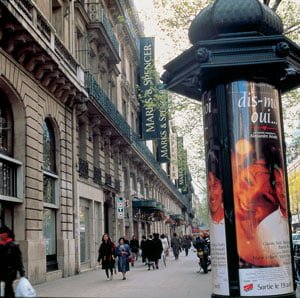
Organisations that wish to be successful in the increasingly competitive markets of the 90s must consider how to provide rewarding roles which allow their employees to develop. In the UK, a career with Marks & Spencer is widely regarded as one of the most interesting opportunities for newly qualified university graduates.
There are always two sides to an employment relationship. Marks & Spencer wants the training and development of knowledge, skills and attitudes of its employees to fit corporate goals, while individuals will want their career to develop to meet their own personal expectations and aspirations. Throughout their working lives, an evaluation process takes place in which individuals constantly ask themselves:
- Where am I now?
- Where do I want to be?
- How will I get there?
The Marks & Spencer brand name evokes a strong, positive public image. Image is a combination of an individual’s personal experience of a company or product, plus what they have read or heard from other sources such as family or friends. Many applications for graduate positions at Marks & Spencer are based upon what the applicants have heard from other people as well as their own experiences.
Image has helped Marks & Spencer attract high calibre people who reflect the organisation’s core values of quality products and service. This is particularly important as creating the right opportunities for employees is about empowerment and trust.
The situation is quite different as Marks & Spencer expands into other countries. Many individuals have not heard of ‘Marks & Spencer’ and do not associate it with the positive image which has been consolidated by over 100 years of trading in the UK. This case study, therefore, focuses upon a new experience for Marks & Spencer! As the growth of overseas business accelerates, Marks & Spencer faces two key issues:
- How to recruit high-quality graduates from other countries
- Having appointed such graduates, how to then cater for the cultural differences in order to provide them with scope for progression which meets their personal requirements?
At the start of the process, other cultures were recognised and strategies were developed, taking into account, as appropriate, the culturally different requirements of both candidates and employees.
The need to build momentum across Europe
When organisations sell their goods in the UK, they are selling to a market of around 58 million consumers. As they extend their horizons further, the opportunities are greater.
In today’s rapidly changing markets, it is essential for ambitious organisations to develop their competitiveness on an international level. Organisations cannot sit behind geographical barriers, complacent in the belief that their product and market share is invincible. For organisations to compete successfully, they must learn to adapt and develop different methods of doing business which provide them with a cost advantage and the ability to differentiate their products from those of their rivals.
The European Union is a large economic region of almost 400 million consumers who have a relatively high annual expenditure on clothing, home furnishings and food. Although Marks & Spencer may be a household name in the United Kingdom, this is not the case in many overseas markets. The ‘internationalisation’ of Marks & Spencer has moved at a cautious pace so far, with developments in Belgium, France, Germany, Spain, Eire and the Netherlands. The new stores have been groomed for success by adapting to local markets, business practices, cultures and consumer preferences.
One of Marks & Spencer’s current objectives is to accelerate the growth of its international business in order to increase market opportunities. The key to this expansion is to offer outstanding value for money and good customer service. The organisation, which demands a lot from its staff, needs to offer plenty in return. It needs to take its responsibilities to the community seriously and value innovation. The objective of accelerated growth can only be met successfully if Marks & Spencer attracts and retains the best available staff.
The problem

Marks & Spencer recruits around 250 university graduates in the UK each year. Marks & Spencer is well known and has a good relationship with graduate career advisors. Marks & Spencer also has a presence on campuses and a well-deserved reputation for training. A long-term presence in this labour market helps Marks & Spencer to find the highcalibre graduates required for the opportunities it has to offer.
Given the aim of accelerated growth in Europe, Marks & Spencer recently set out to recruit a total of 100 graduates from the five European countries in which it operates. It soon became apparent that each of these countries had different higher education systems and widely different recruitment practices. For example, careers advisory services in Spain and the U.K are not comparable and very few Spanish graduates have any work experience. In Germany, graduates leave university at the age of 27!
At Marks & Spencer, senior managers realised that there was no ‘European’ way of doing things. Five different education systems, for example, meant that adaptation was inevitable in order to recognise cultural diversity and ensure equality of opportunity. So while Marks & Spencer wanted a coherent pan-European approach, slightly different strategies were implemented for each of the five countries.
The process

Marks & Spencer began by highlighting the recruitment drive in the media of each country. This was particularly beneficial as it provided Marks & Spencer with high public awareness of store opening announcements and expansion plans, but at a lower cost than advertising. Although the objective was the same in each country, the approach was different. With few store announcements in the Netherlands, it was difficult to interest the press in Marks & Spencer activities. On the other hand, the trebling of the number of stores in Spain (to 12 by the year 2,000) and the employment opportunities this would create, was big news for the Spanish press.
Other problems arose. For example, 13.9% graduate unemployment in Spain meant that job advertisements could attract up to 10,000 applicants! The first stage in the graduate recruitment process is the completion of an application form. This form is then carefully checked to determine whether to invite the applicant for an interview. Before attending an interview, candidates must be prepared to answer probing questions. They may also be asked to carry out some research for discussion at the interview.
Marks & Spencer uses a structured behavioural interviewing format. This means that interviewers seek evidence of predetermined selection criteria. At the initial stage, these are:
- Leadership
- Planning and organising
- Assertiveness
- Analytical consideration
- Job motivation.
However, for continental Europe, assertiveness and analytical consideration were replaced by teamwork and adaptability as these were identified as particularly critical skills for success in a cross-cultural environment. Interviewers explore, in depth, candidates’ experience in activities drawn from education, social life or work (including placements) to determine the degree to which they possess these skills. Throughout the interview, interviewers will be looking for positive reasons to move the candidate on to the next stage of the selection process.
The next stage of the selection process is an assessment centre. This was a new concept for applicants from some countries. Having discussed what they have done in the past at interview, candidates are given the opportunity to actively demonstrate these qualities by performing a series of business related management exercises over a 24-hour period – in which both group and individual work is involved. Assessment centres measure candidates against all seven selection criteria – they have been proven to be the most effective method of predicting successful performance on the job.
After the assessment centre, successful candidates will be offered a job. Before they accept, they are invited to spend a day with Marks & Spencer to find out more about their role and to make a final check on whether they think a career with Marks & Spencer is suitable for them. The considerable evidence gathered at the assessment centre enables a ‘development needs profile’ to be drawn up. This is fed back to the trainee on starting work and forms the basis of his or her individual development plan.
The aim
In the past, Marks & Spencer used up to 34 different criteria when recruiting graduates in Europe. The danger was that in using widely different criteria and recruitment methods, both the quality and consistency of candidates might be affected. Marks & Spencer’s goal was to recruit a truly European manager who could assimilate and work in different cultures, use different languages and be mobile – so that they could use their skills across national boundaries. For this reason, it helped if graduates had:
- Been on an Erasmus programme
- Undertaken part of their studies in another European country
- Lived and worked abroad.
They also needed to understand Marks & Spencer and its operations. For this reason, successful candidates spend up to twelve months training in the UK.
Although it was clear that Marks & Spencer could not impose a single approach on candidates from different countries within Europe, Marks & Spencer wanted broadly similar selection processes, particularly as research within and outside the company had validated Marks & Spencer recruitment practices.
In the UK, Marks & Spencer ranks as one of the top five companies that graduates want to work for. A recent survey in Europe showed that Marks & Spencer did not rank even in the top 120. Thus a different type of problem began to emerge. Marks & Spencer could not simply lift what it did in the UK into Europe because of the different local factors. For example, Marks & Spencer wanted to recruit assertive people but there is no literal French translation for ‘assertiveness’!
Research and consultation

It was important that the UK Head Office was not viewed as imposing its recruitment practices insensitively upon other regions and countries. Marks & Spencer managers therefore talked to Human Resources Managers from companies such as Barclays, United Distillers and Tesco, who had recruited graduates from around Europe. They also talked to recruitment consultancies and efforts were made to understand the comparative differences between educational systems and practices.
Marks & Spencer also consulted widely in continental Europe, using a series of focus groups to ask local managers what they would do if they wanted to recruit high quality graduates.
Developing communication
The research helped to identify the appropriate attraction strategies for each country. This included:
- The design of the application forms
- How to publicise the company and the careers offered
- The nature of presentations to undergraduates on campus
- The development of materials for careers fairs
- The generation of interest in the media.
Information packs were sent to universities providing a basic understanding of Marks & Spencer. Presentations were then made on campus, often after liaison with Business Schools. Interviews were conducted with journalists which focused upon Marks & Spencer’s expansion in Europe and the recruitment of European graduates. This was easier in some countries than others. The response from the media was better in Spain, France and Germany than it was in Belgium and the Netherlands.
Applications

Marks & Spencer received around 1700 application forms for the 100 posts required for five countries. Importantly, however, Marks & Spencer was attracting a low volume of applications from high calibre undergraduates, with 70% going through screening into the interview phase.
This contrasted directly with the high volume of applications in the UK (8500 forms are received for 200 posts) with a greater variation in graduates and only 35% going through to interviews. Research into targeting graduates in other countries provided experience that Marks & Spencer could transfer back to recruitment in the UK.
The assessment centres provided a fascinating insight into cultural diversity. Two experienced UK assessors were used for the assessment process along with two assessors from European management. Notable differences between groups of candidates were soon identified. Although it is difficult to draw generalisations about national characteristics, candidates from the Netherlands were more direct in their approach. In contrast, candidates from France were seen to be more analytical in style and were reluctant to make quick decisions. In fact, they felt that decisions were made too quickly in the UK. They wanted time to rationalise and explore detail before making decisions. The Spanish sessions were characterised by strong team-working skills.
Current research by Marks & Spencer focuses on the extent to which candidates from certain countries have had the opportunity, through their education system, to develop some of the skills necessary for success. So far, it has shown that good candidates from different cultures possess the skills, although they may display them differently. For example, assertiveness is displayed differently by individuals from different nationalities. Training assessors to recognise different cultural characteristics has therefore become a key feature of the assessment centres.
The degree to which successful candidates possess the different criteria is also important in identifying where development needs might lie. A critical criterion, however, is adaptability. Successful candidates, from early on in their career, have to learn to operate across borders and adapt the management style for the different cultures.

The recruitment of European graduates for Marks & Spencer has helped managers to appreciate cultural diversity. It has enabled them to step outside their own culture and develop an understanding and appreciation of multicultural perspectives in the working environment. It was a new experience for a business with an objective for rapid European growth. It was not known how difficult it would be and things did not always go right! However, Marks & Spencer has been able to recruit a pool of high-quality graduates who learn and develop and also provide useful guidance upon developing strategies to create a platform for further growth.



